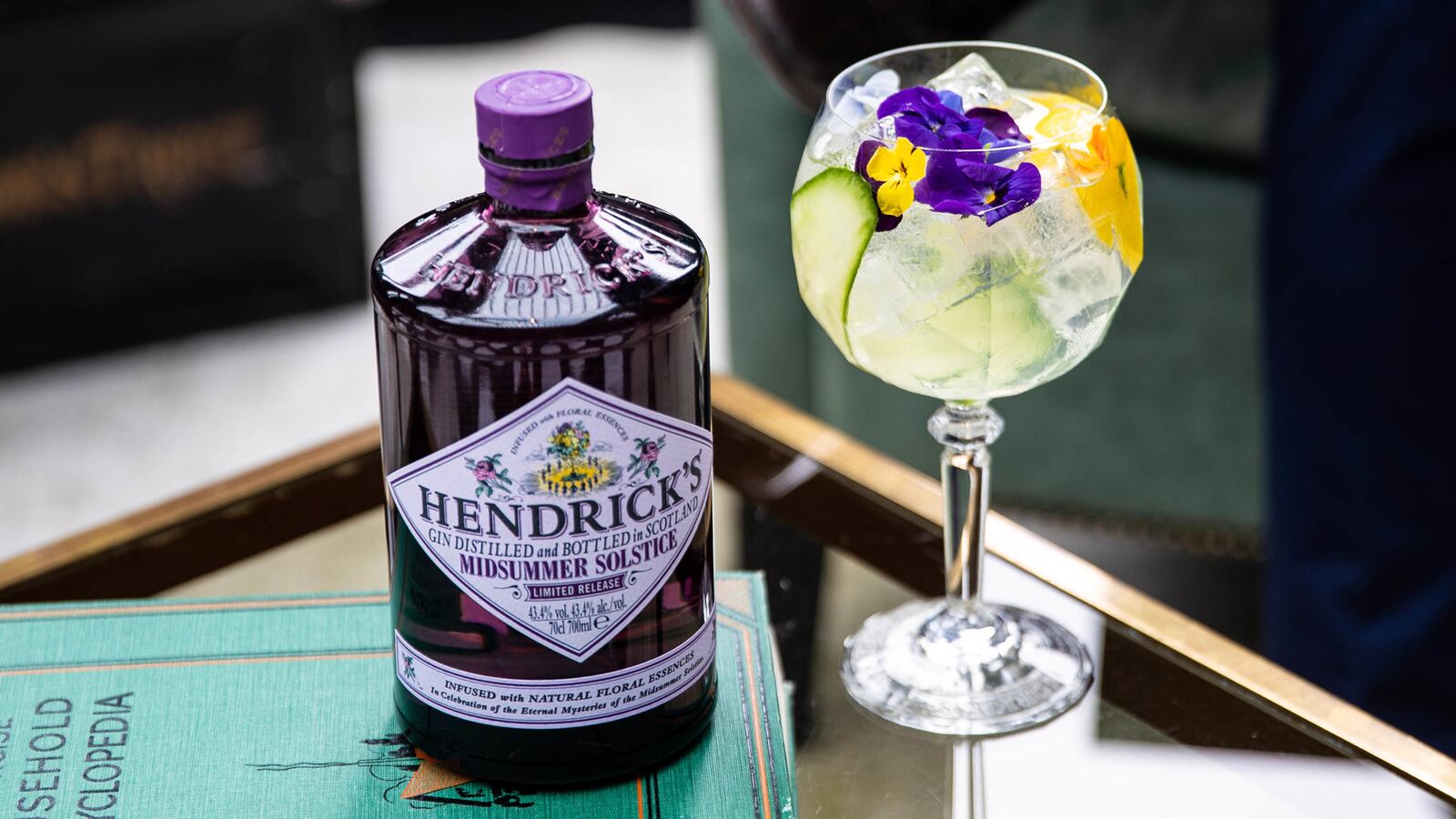The new Hendrick’s “Gin Palace” is about 75 minutes south of Glasgow and almost wholly encased by a Game of Thrones-style black-brick wall. The entrance is a tall gothic door, also painted midnight black.
A group of us on a tour arranged by Hendrick’s approached the gate. We knock. An iPad-sized mini-door some eight feet off the ground swings open and a gnomish face peers out. Inexplicably, none of us shouts, “We want to see the wizard!” Maybe because that’s not needed; the face belongs to Lesley Gracie, Hendrick’s master distiller since 1999. She actually is the wizard.
“Welcome!” Gracie cries out. The doors swing open. Our group enters.
Hendrick’s Gin is celebrating its 20th year this year, and doing so by releasing two new gin products, including Midsummer Solstice, which began rolling out in the United States in early May. Hendrick’s is also showing off its new distillery, which held its grand opening last October. To date, it’s open only to invited guests, including media, distributors and high-profile bartenders, and is not yet offering public tours.

Inside the wall is a showpiece of Victoriana—it’s designed like a 19th century horticultural hall, with a soaring glassed-in pavilion housing palms, a stuffed peacock, comfortable chairs with stacks of outdated encyclopedias. A pair of greenhouses flanks the hall, and it’s here where Gracie grows plants for experimental infusions. Outside the front door there’s a small fleet of penny farthings; the restroom (“Lavatorium”) is adorned with piles of quirky antiquarian books (Simple Heraldry, Cheerfully Illustrated.) Hendrick’s is nothing if not on-brand.
Hendrick’s is celebrating two decades of solid growth. In 2017, it sold more than one million cases for the first time, putting it in the company of a handful of gin producers who move that much liquor. (The club also includes Tanqueray, Beefeater, Bombay Sapphire, Seagram’s and Gordon’s.)
A lot of what has fueled Hendrick’s growth has been quirky marketing—creating a brand with a distinctive identity, one that might be described as “Steampunks Throw a Garden Party.” One mainstay at public events is the Hendrick’s “grand garnisher”—a truck-mounted “bicycle-powered” cucumber slicer the size of an ambitious circus wagon.
When William Grant & Sons first explored the idea of a gin, they approached Steve Grasse, whom Food & Wine magazine once dubbed the “Punk-Rock Prince of Small-Batch Spirits.” Grasse was a marketing guy—his branding agency is now known as Art in the Age of Mechanical Reproduction—and he was instrumental in crafting Hendrick’s quirky image. (Grasse also was behind the Sailor Jerry brand.) The gin’s taglines included “not for everyone” and “a most unusual gin.”

From the distillery’s palm court visitors can view three copper stills behind a wall of glass. It looks like a Smithsonian museum exhibit—indeed, one of these stills dates to 1860. Yet these are fully operating stills, and not just ornamental. In fact, these stills produced all Hendrick’s Gin for the first 20 years. With these, Gracie worked out an early distilling protocol with dual methods of extracting flavors from botanicals. (These include Macedonian juniper, Angelica root, cubeb berry, elderflower, and meadowsweet, among others.) One batch of ingredients is mixed with ethanol and run through a Bennet still, yielding a full extraction. Another batch of identical botanicals is placed in a gin basket atop a Carter-head still, where it infuses the ethanol steam. Each method extracts different layers of flavor, adding what Gracie calls a welcome “roundness.”
The final twist on Hendrick’s flavor profile comes at the end, like a surprise dessert. Hendrick’s has a third party distill both rose petals and cucumber essences with vacuum stills. These stills substantially reduce the boiling temperature of alcohol, helping preserve the delicate flavors. (Cucumber, when exposed to higher temperatures, takes on an unfortunate, cabbage-like aroma, says Gracie.)
To meet anticipated demand for the product, Hendrick’s moved its distillery from a mundane former munitions bunker in the middle of their sprawling property to this specially designed hall. (Although William Grant & Sons is one of the largest producers of grain whisky for blending, visitors to the Hendrick’s facility are spared views of the charmless industrial site thanks to artfully placed berms and trees.)

Hendrick’s also had the three original stills replicated exactly, which they installed in an adjacent room not visible from the main hall. The large room has the charm of a standard distillery, which is to say none at all, but makes up for its lack of quirk with a spotless efficiency. In rolling this out, Hendrick’s has doubled its ability to produce gin, and can now make up to two million cases a year. (Gracie notes the building’s design allows for another room and another trio of replicant stills, meaning they’re ready to gear up to three million cases, if demand warrants.)
So why did Hendrick’s wait two decades to extend its brand line? The answer is both in the production and the marketing.
On the production side, Hendrick’s now has the ability to make nearly twice as much gin as current demand warrants. So what to do with the new capacity? They chose to use the excess to develop new products. The two newly released, limited-edition gins—Orbium and Midsummer Solstice—are comprised of the standard Hendrick's, which is complicated with additional ingredients.
The Orbium, for instance, also contains quinine, wormwood and lotus blossom, in addition to all the regular Hendrick’s ingredients. The result is sort-of lazy person’s gin and tonic, which can be made with the simple addition of soda water. The Midsummer Solstice adds floral essences to the standard product, drawing from flowers that Gracie declines to identify. It was initially created for the wedding of a beloved employee, and will be available until sold out.
The new releases are also rolling out for shrewd marketing reasons. Hendrick’s is often thought of as the original craft gin—among the first to boldly depart from the London dry flavor profile—but as it barrels towards two million cases maintaining that craft imprimatur may prove difficult. What was once a Gulliver amid Brobdingnagians is now a Gulliver amid the Lilliputians—Hendrick’s is now surrounded by dozens of smaller craft gin makers, many departing equally boldly further from the norm and nibbling away at the gin market.
One of the lessons smaller distillers have picked up on is that experimentation helps define them. Larger brands aren’t typically interested in releasing new products unless they’re sure it will sell at least a forty thousand cases out of the gate, with the result of an often-monotonous product landscape among the majors. Craft distillers can be more nimble and experimental with their releases—helping generate interest among bartenders and consumers about what they’re up to, especially when their releases are shrouded in semi-secrecy and limited in release.
So in addition to Orbium and Midsummer Solstice (Orbium is available in “exceedingly small batches and has a finite window of existence,” the company notes), Hendrick’s also made a product called Hendrick’s Kanaracuni, which resulted from a two-week journey that Gracie and others took to the Venezuelan rainforest (with a 10-liter still) to search for new flavors in 2013. They found a plant for infusing called scorpion tail; the extremely small amount that was produced made its way to bartenders and other industry insiders.
Scarcity plus curiosity can help keep a brand in the front and center.
Hendrick’s created the original playbook for craft products—presenting itself as hand-crafted and quirky, the ideal spirit for younger drinkers who didn’t want to drink their parent’s mass-produced gin. Hendrick’s is now borrowing from the craft playbook of a new generation of smaller craft distillers, plotting its way to three million cases, one experimental batch at a time.
Stay tuned.

